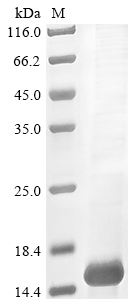Recombinant Tityus zulianus Beta-toxin Tz1 gets expressed in E. coli and covers the complete mature protein sequence from amino acids 21 to 84. The protein comes engineered with an N-terminal 10xHis-tag and a C-terminal Myc-tag, which makes purification and detection much more straightforward. SDS-PAGE analysis shows it reaches over 85% purity - a level that appears suitable for research applications demanding high-quality protein preparations.
Beta-toxin Tz1 from Tityus zulianus is a fairly well-characterized peptide that's known to mess with ion channel activity, especially sodium channels. Being a scorpion toxin, it has become quite important in neurophysiological research. Scientists rely on it to better understand how ion channels work and interact with other molecules. The toxin's distinctive properties may make it a valuable tool for anyone digging into ion channel regulation mechanisms and neurotoxicology.
Potential Applications
Note: The applications listed below are based on what we know about this protein's biological functions, published research, and experience from experts in the field. However, we haven't fully tested all of these applications ourselves yet. We'd recommend running some preliminary tests first to make sure they work for your specific research goals.
Tityus zulianus Beta-toxin Tz1 is a scorpion toxin that requires precise folding, proper disulfide bond formation (typically 3-4 conserved disulfide bonds), and specific tertiary structure for its functional activity in ion channel binding and modulation. The E. coli expression system cannot provide the optimal eukaryotic folding environment or oxidative conditions for correct disulfide bond formation. The dual N-terminal 10xHis-tag and C-terminal Myc-tag are relatively large compared to the small toxin size (∼7 kDa mature protein), potentially causing significant steric interference with the toxin's functional domains and ion channel binding interfaces. While the protein may be soluble, the probability of correct folding with functional ion channel activity is low.
1. Antibody Development and Immunological Research
This application is highly suitable as antibody development relies on antigenic sequence recognition rather than functional protein folding. The full-length mature toxin provides complete epitope coverage for generating antibodies against Tz1. The high purity (>90%) ensures minimal contamination-related issues during immunization protocols.
2. Biophysical Characterization Studies
Basic biophysical characterization can be performed but will not reflect native toxin structure. Techniques like circular dichroism spectroscopy may detect secondary structure but cannot verify functional disulfide bonding. The large tags will dominate the protein's behavior in analytical techniques, masking the native toxin's characteristics. Structural biology techniques requiring native folding will not yield meaningful results.
Final Recommendation & Action Plan
This dual-tagged Tz1 toxin construct is fundamentally unsuitable for functional studies due to the severe steric interference caused by the large tags relative to the small toxin size. The tags (∼11 kDa combined) are larger than the toxin itself (∼7 kDa) and will physically block ion channel binding sites. The only suitable application is antibody development. Application 2 can provide basic physical characterization but will not reflect native toxin properties. For reliable Tz1 research requiring functional activity, use tag-free toxin produced by chemical synthesis or eukaryotic expression systems that support proper disulfide bond formation.






